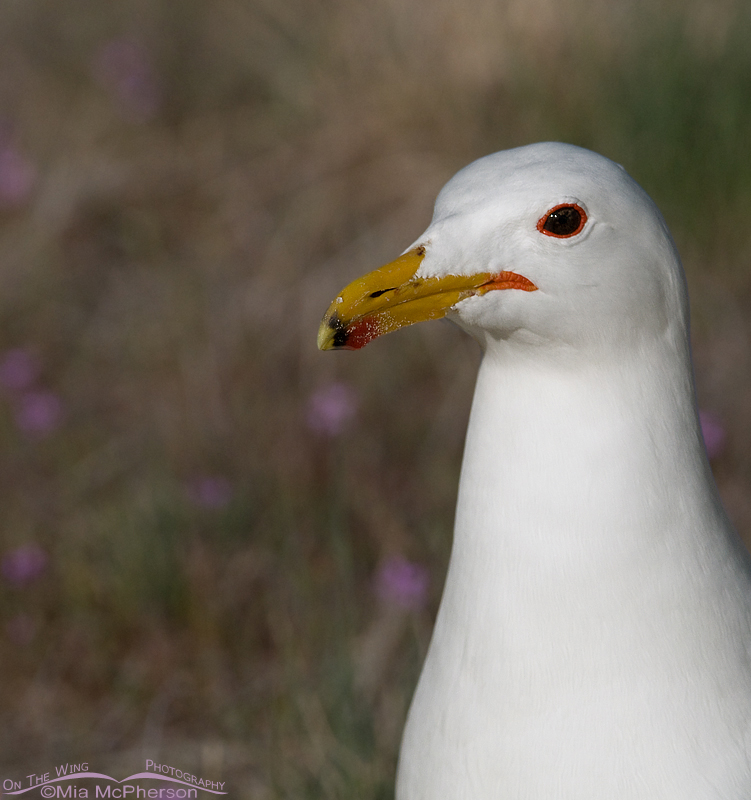Ring-billed and California Gulls
For most of the year Ring-billed and California Gulls are some of the most common gulls here in northern Utah and for some people it might be challenging to tell them apart. Quite often I am asked by friends or other people which gull is which so I thought I’d write about it here on my blog.
 Ring-billed Gull taking an early morning stroll – Nikon D200, handheld, f6.3, 1/750, ISO 200, Nikkor 80-400mm VR at 280mm, natural light
Ring-billed Gull taking an early morning stroll – Nikon D200, handheld, f6.3, 1/750, ISO 200, Nikkor 80-400mm VR at 280mm, natural light
I am only posting adult images here because both species take several years to obtain their adult plumage and I don’t think I have images depicting all of those immature plumage phases for both species. These image were taken in Florida and Utah, I am using images from both locations only because they seemed best for my comparisons.
Ring-billed Gulls are smaller than California Gulls, Ring-billed are 17.5 inches in length and have a wingspread of 48 inches where California Gulls have a length of 21 inches and a wingspread of 54 inches. Ring-billed Gulls are medium-sized gulls and California Gulls intermediate between Ring-billed and the larger Herring Gulls. Size differences in the field can be misleading though so it is important to use other features to ID birds.
Both the California Gulls and Ring-billed Gulls have yellowish legs and feet though the legs and feet of California Gulls are more yellow-green. Both species also have yellow bills.
 Adult California Gull in breeding plumage on Antelope Island – Nikon D810, f8, 1/2500, ISO 400, Nikkor 500mm VR with 1.4x TC, natural light
Adult California Gull in breeding plumage on Antelope Island – Nikon D810, f8, 1/2500, ISO 400, Nikkor 500mm VR with 1.4x TC, natural light
Both the California and Ring-billed Gulls in breeding plumage have clean white heads, chests, bellies and vents with gray mantles. The mantle on Ring-billed Gulls is paler gray than it is on California Gulls but lighting can affect that.
There are also differences in the wing tips, the amount of black in the primaries and the “mirrors” (white spots on primaries or flight feathers) but I will need to leave that comparison for another time.
 Ring-billed Gull close up – Nikon D200, handheld, f6.3, 1/1250, ISO 200, Nikkor 80-400mm VR at 400mm, natural light
Ring-billed Gull close up – Nikon D200, handheld, f6.3, 1/1250, ISO 200, Nikkor 80-400mm VR at 400mm, natural light
I mentioned that both species have yellow bills but there are differences. Ring-billed Gulls have broad black rings near the tip of their bills which is usually evident by their first summer and it is evident all year round in adults. The image above is an adult Ring-billed Gull in non-breeding plumage that show the ring well, if this gull were in breeding plumage the orbital ring around the eye would be brighter red and more noticeable plus the head of the gull would be snowy white. Note the pale eyes.
 Portrait of a California Gull – Nikon D300, f6.3, 1/5000, ISO 640, Nikkor 200-400mm VR at 360mm, natural light
Portrait of a California Gull – Nikon D300, f6.3, 1/5000, ISO 640, Nikkor 200-400mm VR at 360mm, natural light
The bills of California Gulls are larger than seen in Ring-billed Gulls and in adults instead of a black ring around the bill they have black and red spots near the tips of their bills. They do have a black ring around their bills during their second winter but I am writing about adults and a second winter California Gull would not have the full mantle of the adults and its head would have far more streaks.
But… the eyes of California Gulls are nearly always dark and by the second winter Ring-billed Gull eyes are nearly always light. There are of course odd California Gulls that will show up with light irises and Ring-billed Gulls that will show up with dark irises but they are uncommon.
Gull identification isn’t always easy even for adult gulls. I know, for some people a gull is a gull is a gull and trash birds but for me they are interesting and visually appealing along with being challenging to ID.
Life is good.
Mia
To view more of my gull images click here.


Wow Mia…you’ve done it again! What a beautifully nuanced, detail rich, image of the California gull. The contrasts are stunning. Amazing pic. Thanks.
Beautiful images, Mia. Appreciate the lesson in ID.
Count me in on those who like gulls.
Thank you very much for this lesson. So well done. And the images are great.
We can see exactly what you are talking about.